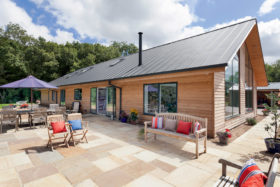
Next session this Thursday. Check out our course programme today!
Use code BUILD for 20% off
Next session this Thursday. Check out our course programme today!
Use code BUILD for 20% offGetting planning permission these days has become a two-step process. Before you get on to the main business of having your plans approved, you must first get your application validated – that is, accepted as being complete and ready to process.
While validation might seem a simple administrative process, sadly it’s become complicated out of all proportion and is now a frequent source of frustration, additional costs and delays, both for self-builders and planning professionals.
Councils can refuse to validate a planning application until all the necessary information is submitted and in the form that the council approves. The issue with this is that it’s only when an application is validated that the clock starts to tick on the eight weeks that the council should take to issue a decision.
Some aspects of validation requirements are universal. The application forms and fees are the same everywhere in the UK, but individual councils can have greatly varying approaches as to the additional information required. There’s also great variation in the zeal with which validation requirements are pursued. For example, some councils accept plans that don’t have ‘scale bars’ drawn on them, while others will reject these. Also, while councils prefer online applications via the Planning Portal, their response to a validation issue might be sent back to you via second class post.
Encouragingly, the Government is talking about cutting through all this red tape and simplifying the system. Less encouragingly, councils were urged by Government to reduce the validation burden a couple of years ago, with precisely zero effect. Meanwhile, though, here are some tips to ensure your application is validated without too many delays:
Councils encourage applicants to seek pre-application advice before formally submitting. Whether this is via a written question and answer or a face-to-face meeting with a planning officer, make sure you ask what, if any additional reports or information the council might want to accompany the application. Make a point of asking about ‘contributions’ – no, not bribes, but the sometimes large sums of money councils demand to pay for things like affordable housing, new road schemes, parks and schools in the local area.
Contributions are often secured via legal agreements, which must be signed before permission is granted. You might have to include a draft agreement with your application and you’ll probably want to run this past your solicitor. Ensure you find out what the council’s validation criteria are, and whether you need to submit a ‘validation checklist’ with your application.
It’s essential to submit the correct number of application forms and accompanying plans, the latter to the scales specified by the council’s validation criteria. If in doubt about questions on the forms, check with a planning officer before submitting. Some councils have a ‘duty planning officer’ who you can get to check over your forms and plans before you submit.
One area mistakes are often made is the certificates of ownership you find at the end of an application. If you own all of the application site, sign ‘Certificate A’ and if you don’t, for example because you have a shared drive, you have to sign ‘Certificate B’ and serve notice of your application on the other owner or owners. If you don’t know who owns the access drive, which is not uncommon with private drives, you have to advertise your application in a local paper.
Many councils produce validation checklists, where they list 30 or more different reports and statements that might be needed with an application. These lists often instruct you to tick what you’re including, and provide an explanation for why any of the reports are being omitted. Don’t take the latter instruction too literally; a ‘catch all’ line or two should suffice.
Don’t forget to pay the council’s application fee – your application won’t be validated without it.
For a new house you’ll need to provide a Design and Access Statement, which your building designer will generally provide in conjunction with their plans. If the planning issues are complex, a separate planning statement might be advisable as well, and if so seek professional advice from a planning consultant. If there are trees on the site you’ll need a tree survey, which is formally known as an ‘Arboricultural Impact Assessment’. Trees often affect layout, so if you’ll be building near trees, get the survey done early so it can inform your plans.
If your site could be home to protected wildlife, you’ll need an ecological survey. For example, old farms and other rural buildings can house bats and where this is suspected, you’ll need a bat survey. This can only be done outside the winter hibernation period, and councils insist on the survey ‘up front’ with the application regardless of whether this sets your project back by months.
Increasingly, councils want an energy statement with an application for a new house. This must show that a given percentage of the house’s energy can be obtained from a renewable source. You might be able to cobble something together from manufacturers’ information, for example on the performance of a particular solar panel you want to use. Failing that you’ll need to obtain a brief statement from an energy consultant.
If you’re converting in a town centre, expect a request for statements dealing with noise mitigation and air quality. These can be quite technical and you’ll need specialist help. As ever, look through the council’s planning application records to find examples of reports that have been prepared nearby and contact the consultants who prepared them. Shop around, as prices for these specialist reports can vary widely.
Validation can be an expensive exercise so, when you’re asked by a council to provide half a dozen reports of questionable relevance to your property, don’t just pay up and commission consultants to provide them. Staff involved with validation of applications are often not professional planners and are undertaking more of a box ticking exercise than a qualitative assessment of what information is needed to properly assess your application.
Accordingly, if you’re not happy, find out which planning officer will be dealing with your application, and speak to him or her. Sometimes a report can be avoided altogether, or its scope can be reduced to something much less expensive, or perhaps something you can provide yourself.
If you’re not happy with the response you get from the planning officer, try enlisting the help of your local councillor, who might be able to lean on the officer on your behalf. It’s not unusual for requests for more detail from validation staff to be wrong, so always scrutinise such demands carefully, and ring up for clarification of any points that aren’t entirely clear.


Comments are closed.